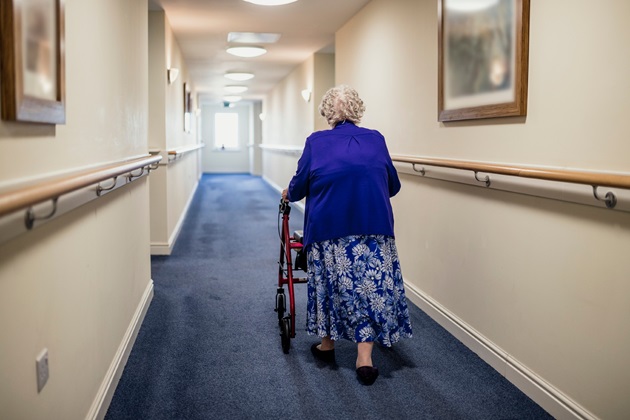Although their contribution is all too often overlooked, temporary workers have been the stalwarts of health care throughout the pandemic, argues a leading agency
Reducing the risks of temporary workers bringing COVID-19 into care homes or being unwittingly exposed to it themselves, was paramount for Fiona Millington.
“Very early on, we developed a process to track care homes with positive cases,” explains Fiona, who is chief nurse with Florence, an online platform which enables nurses to book temporary shifts directly with care home providers.
Before a care home could access the site to post available shifts, they had to answer a series of questions about their clinical situation, with the information made available to nurses who may be considering working there. “It meant they could make a decision about whether or not they felt able to work in a home where there was COVID-19,” says Fiona, who joined the organisation in June 2019.
Nurses were also asked a series of screening questions, such as whether they or a family member had any symptoms or had recently returned from being abroad. Those with a higher risk were contacted by their account manager, with some asked to self-isolate for 14 days.
We need to be clear that agency nurses have the same professional requirements and are regulated in the same way
While some have blamed temporary staff for spreading COVID-19 through care homes, she believes this is scapegoating. “We need to be clear that agency nurses are the same people who work in the NHS or are permanent care home staff,” says Fiona. “They may have chosen to do some extra work or decided to do temporary shifts because it suits their lifestyle. But they have the same professional requirements and are regulated in the same way.
“People were looking for reasons why care homes became so badly affected by the virus, with some saying additional deaths were caused by agency nurses moving between homes – but we knew this wasn’t the case. It was multi-faceted.”
Causes include the rapid transfer of patients from hospitals to care homes, without testing first, she argues. “We needed to be aware of the speed we were transferring people out to where the most frail, vulnerable and at risk were living, because of the great urgency to create bed availability,” says Fiona. “We missed the opportunity to have everything in place that we would have done, if we’d known more.”
A survey of their own nursing staff also revealed how many were badly affected by the lack of personal protective equipment (PPE). “Nurses were telling us they were re-using masks and there weren’t enough gloves,” she says. Traditionally PPE is used infrequently in care homes, so stocks were already low, with smaller homes in particular struggling when prices began rocketing.
The anxieties they felt weren’t just for themselves, but the population they’re caring for
A high proportion of their temporary workers are from black and Asian backgrounds, which increases risks to their own health should they contract the virus. “But the anxieties they felt weren’t just for themselves, but the population they’re caring for,” says Fiona. Sadly, Florence lost two of its staff to the pandemic. “When it’s one of your own and you know those people, it makes it much more real. It’s had such a big impact on the nursing profession,” she says.
Without the contribution of agency nurses, Fiona believes it would have been almost impossible to cope. “They were just as much in demand during the pandemic as before it,” she says.
“Their availability was so important because there was so much sickness in care homes and they were struggling to cover shifts. I was astounded at how good they were and how much they were prepared to put themselves forwards at a time when we were all dealing with something we knew little about, aside from knowing it was dangerous. But they carried on going to work, putting themselves on the front line and wanting to do a good job.”

They carried on going to work, putting themselves on the front line and wanting to do a good job
'I knew what was going to happen'
Although she was initially working as a staff nurse in an NHS hospital, Nomusa Muhlwa felt she couldn’t continue after they began discharging older patients, some of whom had tested positive for COVID-19, back into care homes.
“My conscience didn’t allow it,” she says. “Care homes were being forced to take back residents, regardless of whether they were testing positive for the virus. They were being sent back to be with another set of very vulnerable people. I knew what was going to happen. It would be a domino effect.”
She was warning people about the dangers of the virus back in February, writing about it on social media and raising the issue of personal protective equipment (PPE) at her hospital. “At the time there were only about 20 cases of COVID-19 throughout the UK,” Nomusa recalls.
“I felt we needed to understand much more about what was happening, looking at its impact in China, where it was killing so many people. As long as the planes were still flying from there, this thing was very real. But I was brushed off and it was swept under the carpet.”

Feeling that she was able to exert more sway in care homes, in March, she began agency working full-time, using Florence to find shifts. “Care homes listen to you,” says Nomusa, who qualified in 2008 and is active in the RCN. “Here the nurse in charge runs the shift and can influence managers. In the NHS it’s quite hierarchical.” In one of her regular care homes, she asked if they could stop outside visitors coming in. As a result, they were one of the first to lock down, before the government implemented the policy nationally. “It felt cruel at the time, but it was a necessary evil,” she says.
But unfortunately, many homes were unable to prevent COVID positive residents from being discharged from hospital back to them, where they struggled to isolate them. In April, Nomusa contracted the virus herself and was ill for a month. “I know exactly where I got it from,” she says. “I’d been told that a care home had full PPE but when I got there it was literally a plastic apron and a mask. At this point, those working in hospitals were wearing full PPE, with visors and everything else. It was inevitable it would happen.”
Care homes listen to you
Nomusa found the experience terrifying. “The anxiety makes your breathing even worse. I couldn’t smell or taste anything. My kidneys were also very painful. I was trying to isolate from my children as much as I could and they didn’t get it,” she says. “Surviving the virus has given me the confidence that my body has the ability to fight it.”
Now fully recovered and back at work, she is shocked at how many residents have died at the care homes where she regularly works, with some losing as many as half. She also lost a colleague, who was a health care worker. “I feel really sad,” says Nomusa. “You could see how infectious it was in China, but the government here wasn’t responsive enough. It makes me angry.”
Words by Lynne Pearce








